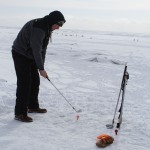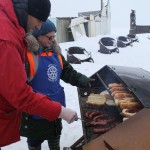Throughout the race when there has been enough bandwidth to support a SKYPE call, I’ve talked with several schools back home in Wisconsin. The students at one school had created a list of numbers, similarities and patterns. Aliy has captured second place in three consecutive Iditarod races. The time difference this year was 2:22. Dallas Seavey was 4th in 2011, 1st in 2012, 4th in 2013 and 1st in 2014 when he was wearing bib #14. They were wondering if he was predestined to 4th place next year.
 There’s been a group of tourists wearing red jackets following the race. The first place we talked was in McGrath. They were at the checkpoint for the day then moving down the trail. A few days later the same race fans still wearing red jackets were in Unalakleet. I bumped into the group just as they were leaving the checkpoint and heading over to Peace on Earth for pizza. Now we’re in Nome. When I saw them at the Mini, Nome’s Convention Center and Iditarod HQ, I asked if they’d had a precious experience during their Iditarod travels. The fellow thought his favorite moment was in Unalakleet. Travis Beals, bib #48 came into the checkpoint just before 1400. What he didn’t know was that his fiancée had boarded a plane at about the same time in Anchorage to come to Unalakleet to surprise Travis. She arrived a couple hours before Travis departed for Shaktoolik. You can only imagine the confusion Travis experienced when Sarah woke him from his nap in the checkpoint. Of course she can’t help Travis with dog chores or preparation to depart the checkpoint but they did have that couple of hours to chat. The woman I asked also had a favorite experience. She described how fortunate she felt being in the villages of Nicolai, Takotna and White Mountain. While there she had the opportunity to get close to the race but also the time to connect with villagers. These opportunities were indeed priceless.
There’s been a group of tourists wearing red jackets following the race. The first place we talked was in McGrath. They were at the checkpoint for the day then moving down the trail. A few days later the same race fans still wearing red jackets were in Unalakleet. I bumped into the group just as they were leaving the checkpoint and heading over to Peace on Earth for pizza. Now we’re in Nome. When I saw them at the Mini, Nome’s Convention Center and Iditarod HQ, I asked if they’d had a precious experience during their Iditarod travels. The fellow thought his favorite moment was in Unalakleet. Travis Beals, bib #48 came into the checkpoint just before 1400. What he didn’t know was that his fiancée had boarded a plane at about the same time in Anchorage to come to Unalakleet to surprise Travis. She arrived a couple hours before Travis departed for Shaktoolik. You can only imagine the confusion Travis experienced when Sarah woke him from his nap in the checkpoint. Of course she can’t help Travis with dog chores or preparation to depart the checkpoint but they did have that couple of hours to chat. The woman I asked also had a favorite experience. She described how fortunate she felt being in the villages of Nicolai, Takotna and White Mountain. While there she had the opportunity to get close to the race but also the time to connect with villagers. These opportunities were indeed priceless.
It’s inevitable in Iditarod that teams will scratch. Sixty-nine teams started the race with forty-nine making the burled arch in Nome. Twenty teams scratched along the way. That’s 29%. Folks might be quick to think that’s an all time high but it’s not. Go back to 2007, the first year Lance Mackey won. Eighty-two teams started and 24 scratched which also comes out to 29%. Go back to 2003 the year the race start was moved to Fairbanks. Sixty-four teams started and twenty scratched for 31%. Go back even further to the early days of the race, 1975, when Emmitt Peters covered the trail in 14 days. Forty-one teams began the race and sixteen scratched. Do the math, 31% of the mushers didn’t make it to Nome that year. Was it the weather, the trail or a virus? Have to ask the old-timers about that.
- Golf Anyone?
- Grilling Reindeer Sausage
- Native Craft Fair in Nome
There are so many happenings in Nome during the race, it’s impossible to see all the mushers arrive and experience Nome. The championship games for the largest basketball tournament in the world, the Lonnie O’Connor Iditarod Basketball Classic, are being played today. Forty teams from rural Alaska have been competing over the past week. They play a fun, run and gun type basketball, the scores are high and the games are exciting. The Nome Noon Rotary Club served up grilled reindeer sausage at a cookout near the edge of the Bering Sea at noon on Friday. While it was a little windy and snow was falling, everyone enjoyed what might have been their first cookout of the year. Tee times were available in Nome today for the Bering Sea Golf Classic. The course consisted of nine holes. The first tee was on the sea wall behind the visitor’s center. Shotgun shell casing were used as tees and contestants carried a seven iron and a putter. At the Old St. Joseph’s Catholic Church the Iditarod Native Craft Fair attracted droves of shoppers. On Front Street the National Park Service presented films, talks and daily hands on demonstrations and crafts. This morning I watch Sled Dogs: An Alaskan Epic produced by PBS as part of their nature series. The best line in the movie was delivered by an Inupiag woman who came down to see the mushers and teams parked in Unalakleet. She said, “I still have one sled dog. His name is Honey. I don’t call my husband honey but I call my dog Honey.”
Wondering what family has been involved in the Iditarod for the greatest number of years? It takes some time going through the archives but I checked out three family names – Mackey, Seavey and Redington. Mushing is a family affair for all of these clans. Representing the Redington name are 3 generations – Joe Sr. and Joee, Raymie and his sons Ray Jr. and Ryan. The Seavey family is another 3-generation trail clan with Grandpa Dan, son Mitch and his sons – Tyrell, Danny, Dallas and daughter-in-law, Jen. The Mackey family tradition started with Dick and continues with sons Rick, Lance and Jason. It’s the Mackeys that have been involved in Iditarod for the greatest number of years. They’ve been on the trail in all but seven of the forty-two Iditarod races.




































